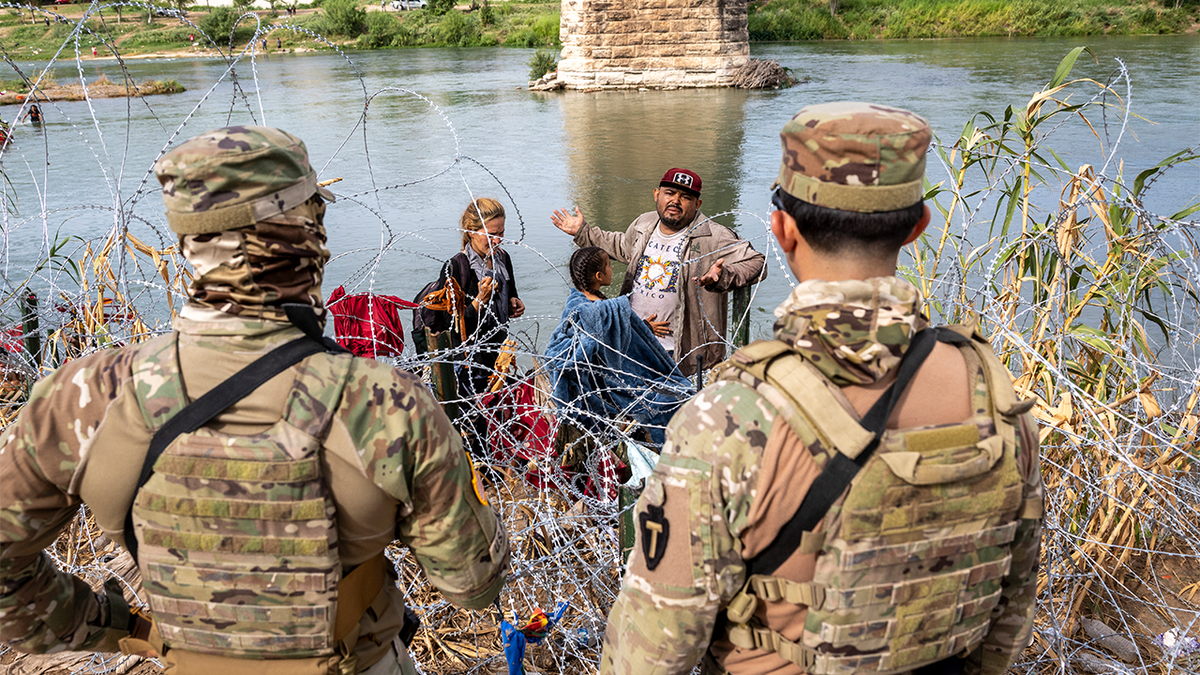Southwest
Texas has spent millions placing razor wire along the border: Is it working?

In the past couple of years the Texas National Guard and state authorities have placed over 100 miles of razor wire at some of the most critical migrant crossing points along the southern border. The state, which makes up over 60 percent of the U.S. border with Mexico, has spent well over $10 million erecting and maintaining these border barriers as part of its larger multi-billion-dollar border enforcement campaign “Operation Lonestar.”
This week, a federal appeals court ruled against the Biden administration’s attempt to block Texas from continuing to place walls of razor wire – also called concertina or “c-wire” – along the border. This comes after U.S. Border Patrol agents under the Biden administration cut down Texas’ wire on a 26-mile stretch of the border in September 2023.
Earlier this year, Texas Governor Greg Abbott, a Republican, said that “Biden should be thanking Texas, not obstructing our efforts to secure the border.”
“Joe Biden completely abandoned his constitutional duty to secure the border. Texas stepped up in his absence to build the wall, repel illegal crossings, and protect our country,” said Abbott.
HEARTBREAKING VIDEO SHOWS 10-YEAR-OLD MIGRANT LEFT ALONE AT BORDER
Texas Gov. Greg Abbott announce the deployment of an inflatable barrier along the Rio Grande River on Thursday, along with a six-bill package he signed to bolster border efforts. (Gov. Greg Abbott’s Office)
But does razor wire really keep migrants from entering the country illegally, and is it worth the cost?
Andrew Arthur, a law and policy expert at the Center for Immigration Studies, says the answer is an emphatic “Yes.”
He pointed to data from U.S. Customs and Border Protection that shows illegal migrant encounters in Texas’ five border sectors dropped by nearly two-thirds in January after the state finished placing wire.
Arthur told Fox News Digital that Texas began placing wire fortifications in May 2023 after the COVID-era measure Title 42 expired. Then, after the migrant surge in December, Texas deployed additional guard personnel, state troopers and resources to the border.
“Based on the numbers that we’re looking at here, it is most definitely effective,” he said.

Members of the U.S.military place razor wire along the U.S.-Mexico border on the McAllen-Hidalgo International Bridge, Friday, Nov. 2, 2018, in McAllen, Texas. (AP Photo/Eric Gay)
INCOMING BORDER CZAR HOMAN ISSUES WARNING IN TEXAS TO DEMS OPPOSING TRUMP DEPORTATIONS: ‘DON’T TEST US’
“What the wire did from my reading of this is it shifted that flow west,” he explained. “And that’s important, because that’s a much longer route. You’re adding hundreds of miles to that smuggling journey.”
While effective, razor wire is not without drawbacks. More than a traditional border wall, wire needs to be constantly monitored. It also requires regular upkeep and additional wire being laid down after old wire is damaged or destroyed.
“It’s a temporary solution, because you’re going to have to replace the concertina wire that they have and, at some point, they’re not going to be able to keep sending wave after wave of troopers, because a lot of those guys are hundreds of miles from their homes, because Texas is a big state,” he explained. “When I was embedded with a trooper down there, he was from Abilene, which is nowhere near the border, and he had been there for six weeks.”

A Texas National Guard soldier stands on patrol near the banks of the Rio Grande on April 2, 2024, in El Paso, Texas. (Photo by Brandon Bell/Getty Images)
There are also humanitarian considerations.
Arthur said that by being an effective deterrent, razor wire protects migrants from attempting the dangerous crossing over the Rio Grande.
Meanwhile, Dylan Corbett, who runs an El Paso-based migrant aid and advocacy group called the Hope Border Institute, said that the presence of c-wire along the border has increased migrant injuries and deaths.
Corbett told Fox News Digital that doctors working with the Hope Border Institute have had to treat the wounds of families injured by the wire, as well as “wounds caused by projectiles fired by the National Guard.”

Venezuelan immigrant Louis Sanchez asks Texas National Guard troops to let his family pass through razor wire after they crossed the Rio Grande from Mexico on September 27, 2023, in Eagle Pass, Texas. (John Moore/Getty Images)
“In El Paso, nearly our entire border has been fortified by layers of concertina wire, including part of our border with New Mexico,” he explained. “While the numbers of border deaths along the whole border appear to have gone down over the past year, in El Paso they have increased. That increase has been sharp over the past couple years and coincides with the presence of the Guard and the concertina wire, because it is forcing border crossers just to the west of the city, where they die in the desert or crossing the river.”
He called for the federal government to finally step in and “assert its supremacy over managing migration at the border and fix our overall system.”
“More people are dying here than ever before,” he said. “The longer we wait, states will continue to engage in uncoordinated and irresponsible enforcement actions on their own, unnecessarily putting lives at risk and needlessly diverting millions of dollars in taxpayer resources.”
Read the full article from Here

Los Angeles, Ca
Sailor to be buried in California nearly 83 years after Pearl Harbor attack

An Ohio native who was killed in the 1941 attack on Pearl Harbor will be brought to his final resting place in California one day before the 83rd anniversary of the infamous air raid on the island of Oahu in Hawaii.
Fireman 2nd Class William Kubinec was one of 105 casualties from the USS West Virginia during the Japanese attack that also sunk the USS Oklahoma, USS California and USS Utah on Dec. 7, 1941.
Kubinec enlisted in the Navy on Sept. 4, 1940, as a Seaman Apprentice and advanced to Seaman 2nd Class, Fireman 3rd Class and finally Fireman 2nd class.
“Despite the name, this rating is not just about fighting fires. Part of the job functions include rescue, but the career path is also geared towards engineering. Fireman stand engineering watches, as well as power plant and ship security watches both in port and while underway, and are responsible for performing minor maintenance repairs. While performing watches they ensure all safety standards are being met with any associated engineering machinery. Fireman also assist with underway replenishment including transferring fuel and supplies,” the U.S. Navy stated in a release.
Kubinec, who was 21 years old at the time of the attack, was awarded a Purple Heart Medal, Combat Action Ribbon, American Defense Service Medal (Fleet Clasp), Asiatic-Pacific Campaign Medal (Bronze Star) and a World War II Victory Medal.
The Defense POW/MIA Accounting Agency (DPAA) began the process of identification for unresolved casualties aboard the USS West Virginia in 2017 by using DNA and/or isotope analyses.
Kubinec will be buried at 2 p.m. Friday in the Northern California Veterans Cemetery in Igo, California.
He was born on Dec. 16, 1919, in Garrettsville, Ohio, but his family currently resides in Redding, California.
Southwest
Texas day care worker allegedly kicked toddlers more than 100 times, stood on their hands as punishment

A Texas day care worker was arrested on accusations she kicked and pushed at least six toddlers over a three-month period.
Catherine Guziejka, 44, was booked into the Smith County Jail on Oct. 30 on six counts of injury to a child with the intent to cause bodily injury. She remains in custody, according to local outlet CBS 19.
A staffer at Punkin’ Doodles Day Care in Lindale, Texas, allegedly came across footage of some of the incidents. That staffer then notified a victim’s father, who contacted investigators.
The Smith County Sheriff’s Office is still reviewing surveillance footage from the day care, CBS 19 reported.
FLORIDA DAYCARE WORKER ALLEGEDLY ANGRILY HIT CHILD, THREW HER TO FLOOR DURING TIMEOUT
Catherine Guziejka, 44, is facing six counts of injury to a child with the intent to cause bodily injury after allegedly kicking and pushing toddlers at the day care where she worked. (Smith County Jail records)
The sheriff’s office said Guziejka was seen in the footage kicking six toddlers on 134 separate occasions between July and October. In one incident, Guziejka allegedly kicked a 2-year-old boy in his lower back while he was lying on the floor.
Many of the videos showed a child watching TV when Guziejka allegedly came from behind and kicked them in the back.
The kicking incidents were observed on about 21 separate occasions, and the children were all two years old.
Several videos appeared to show her walking around as the children napped and aggressively adjusting them or moving them. Toddlers were also pulled from their beds during naptime and dragged by their arms to a changing table.

Catherine Guziejka, 44, was booked into the Smith County Jail on Oct. 30. (iStock)
In several videos, Guziejka allegedly laid kids on the changing table aggressively, pushing their heads down and forcing them to face the wall as they attempted to look in the direction of the TV.
She is also accused of punishing some toddlers by standing on their hands.
A video showed Guziejka allegedly standing on a child’s left hand for seven seconds as the child attempted to pull their hand away in pain.
Deputies said the children were not being disruptive in the videos before Guziejka appeared to assault them. Deputies also said she was not seen attempting to console or comfort the children.
GEORGIA DAYCARE EMPLOYEE ARRESTED AFTER ASSAULTING CHILD ON VIDEO: POLICE

The sheriff’s office said Guziejka was allegedly caught on video kicking six toddlers on 134 separate occasions between July and October. (iStock)
CLICK TO GET THE FOX NEWS APP
The sheriff’s office said it was apparent that Guziejka’s actions were random, intentional, unprovoked, violent in nature and done for the sole intent of inflicting pain.
Guziejka, who first began working at the day care in September 2023, was fired the day the day care’s owner learned of the abuse against the children.
The owner said she immediately called law enforcement and the Texas Department of Family and Protective Services to investigate Guziejka’s behavior. The agency determined she could no longer work at any day care, hospital, nursing home or facility that cares for vulnerable people.
The day care has since been sold to a new owner.
Read the full article from Here
Los Angeles, Ca
Canyon Crest Fire fully contained at 254 acres

Crews announced Sunday evening that the Canyon Crest Fire has been fully contained at 254 acres.
The fire, which scorched parts of Riverside County bordering San Bernardino County, prompted evacuation warnings when it broke out around 5:30 p.m. on Thanksgiving.
According to CAL FIRE, the fire started near Canyon Crest Drive and Weeping Willow Lane in the Fontana area by the San Bernardino Fire Department.
San Bernardino County Fire first reported crews were on the scene of a 100-by-100-foot spot fire running uphill.
The department soon upgraded the fire from 2nd to 3rd alarm after the flames grew to about 10 acres with a moderate rate of speed. Within the next three hours, the fire grew to about 85 acres and was 0% contained.
Evacuation warnings were issued for the area of the Moreno Valley (60) Freeway east of Country Village Road, south of the county line and west of Sierra Avenue, according to officials.
“The evacuation warning was lifted shortly after noon Friday, and an evacuation center that had been established at Jurupa Valley High School was closed,” stated a Riverside County Fire Department press release.
Although no structures were reported damaged in this fire, the flames burned near several homes on Thursday evening.
“Crews made steady progress over the weekend,” said Riverside County Fire. “The fire was mapped at 284 acres and 50% contained at 8 a.m. Saturday, but was revised to 254 acres on Sunday.”
By 7 p.m. Sunday, the fire department confirmed that the Canyon Crest Fire had been 100% contained.
No injuries were reported, and CAL FIRE says the cause of the fire remains under investigation.
-

 Science6 days ago
Science6 days agoDespite warnings from bird flu experts, it's business as usual in California dairy country
-

 Health1 week ago
Health1 week agoHoliday gatherings can lead to stress eating: Try these 5 tips to control it
-

 Health1 week ago
Health1 week agoCheekyMD Offers Needle-Free GLP-1s | Woman's World
-

 Technology6 days ago
Technology6 days agoLost access? Here’s how to reclaim your Facebook account
-

 Entertainment5 days ago
Entertainment5 days agoReview: A tense household becomes a metaphor for Iran's divisions in 'The Seed of the Sacred Fig'
-

 Technology4 days ago
Technology4 days agoUS agriculture industry tests artificial intelligence: 'A lot of potential'
-
/cdn.vox-cdn.com/uploads/chorus_asset/file/24007866/acastro_STK109_microsoft_02.jpg)
/cdn.vox-cdn.com/uploads/chorus_asset/file/24007866/acastro_STK109_microsoft_02.jpg) Technology1 week ago
Technology1 week agoMicrosoft pauses Windows 11 updates for PCs with some Ubisoft games installed
-

 Sports2 days ago
Sports2 days agoOne Black Friday 2024 free-agent deal for every MLB team















